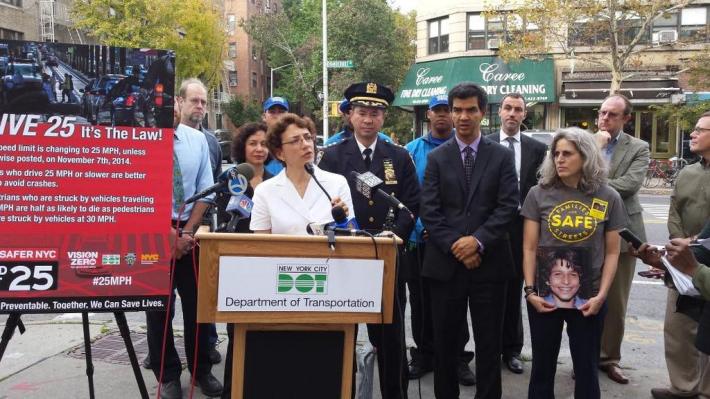
After a powerful advocacy campaign that convinced Albany and the City Council to lower NYC's default speed limit to 25 mph, the new law is set to take effect November 7. City officials and street safety advocates launched a public awareness campaign today at the intersection of Vanderbilt Avenue and Park Place in Prospect Heights to make sure New Yorkers know the new speed limit and why driving slower saves lives.
Unless signs say otherwise, the speed limit on all city streets will shift from 30 mph to 25 mph. (Some large arterial streets like Queens Boulevard will retain higher limits.) Transportation Commissioner Polly Trottenberg, NYPD Chief of Transportation Thomas Chan, City Council transportation committee chair Ydanis Rodriguez, and representatives from Transportation Alternatives and Families For Safe Streets, who helped win passage of the enabling legislation, were on hand today to bring the message home.
DOT is urging New Yorkers to use the #25mph hashtag on social media to share why driving at a safe speed is important to them.
Joint DOT/NYPD "street teams" have been distributing flyers about the new speed limit on major streets. Last week, 16,000 flyers were handed out on Staten Island's Hylan Boulevard, and the street teams are now canvassing White Plains Road in the Bronx. Radio ad buys began today, and print and online media PSA campaigns will begin later this month. DOT says it will be working with local elected, community boards, BIDs, and neighborhood non-profits to spread the word as well.
Getting the word out matters not only because the speed limit is changing, but also because even before the new law, it was an obscure piece of information. Most New Yorkers feel that speeding is a safety problem in the city, according to a 2010 DOT survey, but the same survey also found that two-thirds of New Yorkers didn't know the speed limit.
This campaign should help popularize facts about the dangers of speeding that Streetsblog readers know well: Driving too fast for conditions limits motorists' ability to react and avoid collisions, and it drastically increases the risk of severe injury or death in the event of a crash.
"For those of us who drive, this change should be seen as an opportunity to become a lifesaver," said Amy Cohen of Families For Safe Streets, whose son Sammy was killed by a motorist on Prospect Park West. "If this new and safer speed limit is obeyed and properly enforced, New York City can reduce the number of people senselessly killed and seriously injured in traffic."
Today's event is going to get blanket coverage in the local press -- TV, radio, print, and online. If all those reporters accurately convey the safety rationale for driving slower on city streets, it will be one step toward achieving the culture change necessary for Vision Zero to succeed.





